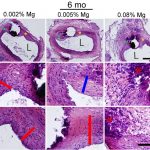Our internal collaborators from Biomedical Engineering, together with collaborators from Mayo Clinic, were instrumental in preparation and publishing of a new report on biocompatibility of Zn-based materials. The paper entitled Improved Biocompatibility of Zn-Ag-based Stent Materials by Thermal Processing was published in Acta Biomaterialia.
The metallurgical engineering of bioresorbable zinc (Zn)-based medical alloys would greatly benefit from clarification of the relationships between material properties and biological responses. Here we investigate the biocompatibility of three novel Zn-based silver (Ag)-containing alloys, ranging from binary to quinary alloy systems. Selected binary and quinary Zn-Ag-based alloys underwent solution treatment (ST) to increase the solubility of Ag-rich phases within the Zn bulk matrix, yielding two different microstructures (one without ST and a different one with ST) with the same elemental composition. This experimental design was intended to clarify the relationship between elemental profile/microstructure and biocompatibility for the Zn-Ag system. We found that the quinary alloy system (Zn-4Ag-0.8Cu-0.6Mn-0.15Zr) performed significantly better, in terms of histomorphometry, than any alloy system we have evaluated to date. Furthermore, when solution treated to increase strength and ductility and reduce the fraction of Ag-rich phases, the quinary alloy biocompatibility further improved. We conclude that Zn-Ag alloys can be engineered through alloying to substantially reduce neointimal growth. The positive effect on neointimal growth can be further enhanced by dissolving the AgZn3 precipitates in the Zn matrix. These findings demonstrate that neointimal-forming cells can be regulated by elemental additions and microstructural changes in degradable Zn-based implant materials.
Biocompatibility of Zn-Ag Alloys
This entry was posted in Publications. Bookmark the permalink.

